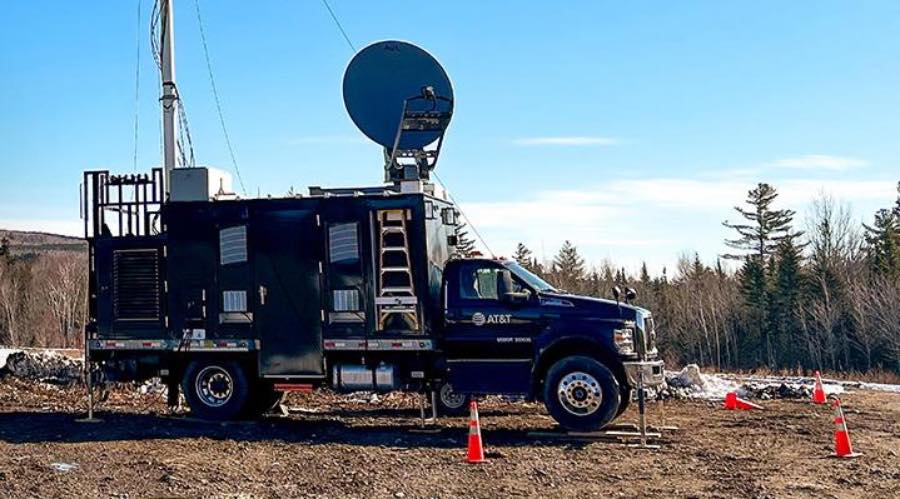
The total solar eclipse in April brought massive crowds to 15 U.S. states in the path of totality. The eclipse was a unique and challenging event for emergency management. Each state required different types of support to ensure their public safety agencies were prepared for the influx of people.
The FirstNet Authority began working with public safety officials over two years ago to incorporate broadband into their eclipse planning. Let’s look at how the FirstNet Authority supported some of the states in the path of totality.
In Texas, Oklahoma, and Arkansas, the FirstNet Authority organized at the federal level to support the states, including coordinating with the Department of Homeland Security’s FEMA and Cybersecurity and Infrastructure Security Agency.
Through this coordination, maps were created showing an overlay of three important sources of information: the path of totality, locations of planned events, and FirstNet network capabilities.
These overlay maps proved invaluable in preparing for the eclipse. Local agencies used them to determine if FirstNet deployables were needed in their area. This streamlined the deployable process, reduced competing requests, and prioritized areas most in need of boosted coverage.
As a result, communications were reliable during the eclipse when public safety in these three states needed it most.
In Illinois, the city of Carbondale was one of the few places in the path of totality for both the 2017 and 2024 eclipses.
In 2017, Carbondale public safety struggled with crippling traffic issues. In 2024, the city planned a festival around the eclipse to be able to better predict and manage the crowds.
FirstNet Authority teams supported the eclipse preparation in Illinois by conducting drive testing for FirstNet before the event. This helped to assess the coverage, capacity, and quality of service for the network in Illinois during the eclipse.
The northwest corner of Pennsylvania fell within the path of totality for the eclipse. To prepare, public safety officials conducted pre-planning sessions with the FirstNet Authority.
In these sessions, the FirstNet Authority included the AT&T radio access network team that analyzes and supports network connectivity.
After working together with local officials to understand their needs during the eclipse, AT&T accelerated the timeline for building a new cell site near a high-traffic area. This new site was ready in time for the eclipse and successfully handled public safety communications.
Public safety officials in the western part of New York conducted pre-planning sessions with the FirstNet Authority to ensure sufficient coverage and capacity during the influx of people.
On the day of the eclipse, cloud cover blocked views of the sky in western New York, shifting the crowds to the eastern and northern parts of the state.
This sudden change meant crowds in northern New York spontaneously gathered near a remote rest stop off a highway. The one local cell site had only a small amount of spectrum, which caused issues during the peak of the eclipse.
This unusual event identified areas where additional coverage is needed, and AT&T is now enhancing coverage in that part of the state.
The Vermont Department of Public Safety owns and manages their own FirstNet deployables. Public safety officials used the state’s Compact Rapid Deployables, or CRDs, and the state’s miniCRDs™ to support communications during the eclipse.
CRDs and miniCRDs are versatile because of their small size and ease of use. A single person can transport and set up these assets within a matter of minutes.
By owning their deployables, Vermont agencies had the discretion to send deployables where and when they wanted. This allowed state leaders to customize its FirstNet coverage and capacity to accommodate the crowds.
Maine and New Hampshire are already destinations for nature lovers, so state officials knew to expect big crowds for the eclipse. The FirstNet Authority hosted several pre-planning sessions in both states.
One series of pre-planning was held with the Jackman region in Maine, a popular yet remote recreation destination.
“This was a historic event for the Jackman region,” said Chief Bill Jarvis of the Jackman-Moose River Fire and Rescue Department. “Although we had significantly more visitors in our region for the eclipse than expected, we had very few incidents.”
Through the pre-planning efforts, two deployables were stationed in strategic areas in each state, and the network was optimized for high traffic.
“I offer my sincere thanks to the FirstNet Authority and AT&T for being involved with the planning meetings and for setting up a temporary cell tower and Cell Booster Pros where needed in the region,” said Chief Jarvis. “With the assistance and support of so many, this was a wonderful and safe event for our community.”